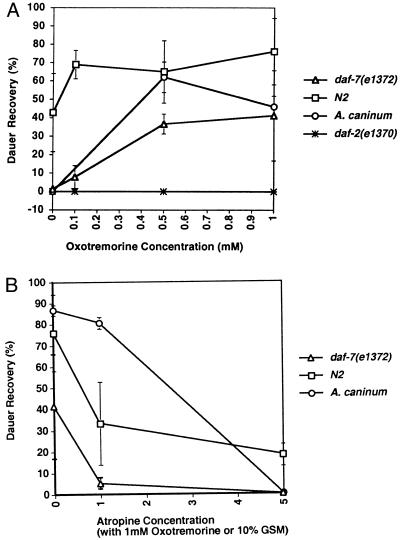Figure 1.
The effect of muscarinic agonists and an antagonist on dauer recovery in C. elegans and A. caninum. (A) Oxotremorine, a synthetic muscarinic agonist, promotes dauer recovery in both C. elegans and A. caninum. daf-2(e1370) fails to recover at all drug concentrations. The scale for the drug concentration for A. caninum is 10×. All points are the average of two experiments, where at least two plates were scored with the exception of 100 mM daf-7, N2, daf-2, where only one experiment was done. (B) Atropine can specifically inhibit the muscarinic agonist-induced response. In C. elegans, at 1 mM oxotremorine, as the concentration of atropine, a muscarinic antagonist, is increased, dauer recovery is completely inhibited. In A. caninum L3 incubated with serum and GSM plus atropine (5 mM), dauer recovery was inhibited by 99.5% (from 86.7% to 0.5%). Similarly, in A. caninum larvae, 0.5 mM arecoline and increasing amounts of atropine cause dauer recovery to be completely inhibited. Concentrations of 1–5 mM of a drug are used routinely in drug assays in C. elegans (13, 14, 24). The unusually high doses may be due to a cuticle permeability barrier. Drugs in the following classes were tested on daf-7(e1372) and daf-2(e1370) mutant strains for dauer recovery and on wild type and the daf-22(m130) mutant for dauer induction and had no reproducible effect on dauer recovery or formation. (a) Noradrenaline/adrenaline: cocaine*, imipramine*, reserpine*, tetrabenazine*, clonidine, isoproteronol, epinephrine, propanolol, and metopolol; (b) serotonin: 5-hydroxytryptamine, p-chlorophenylalanine, and spiperone; (c) opioids: hydromorphone, meperidine, nalorphine, PCP*, and methaqualone; (d) dopamine: dopamine and metoclopramide; (e) γ-aminobutyric acid: muscimol, diazepam, pentobarbitol, bicuculline, and picrotoxin; (f) glutamate: NMDA, kainate, α-amino-adipate, glutamate diethyl ester, and quisqualate. *, Affects multiple signaling pathways.

